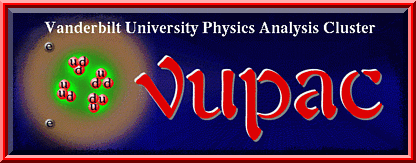
VUPAC is a workstation farm: a cluster of workstations coupled loosely together to provide a (very coarse) parallel computing environment. Many compute intensive calculations do not require tightly coupled systems, and it is possible to build workstation farms with significant compute power for a fraction of the cost of tightly coupled or mainframe computers.
VUPAC is primarily being used to make atomic structure calculations and to reconstruct data and perform Monte Carlo calculations for elementary particle and relativistic heavy-ion experiments (see ``VUPAC Physics'' below). It has also been used by physicists and astronomers in the department for other purposes, such as calculating the electromagnetic fields surrounding DNA molecules and studying radiative transfer models for supernova atmospheres.
VUPAC was designed and implemented with the invaluable assitance of Denny Burnum, Frank Kyle, and Esfandiar Zafar of Vanderbilt Academic Computing and Information Services. Initial support for the project was provided by a National Science Foundation (NSF) Academic Research Infrastructure grant with matching funds from Vanderbilt University. Subsequent upgrades, administration, and maintenance have been funded by the NSF and the Department of Energy.
![]()

VUPAC Physics
![]()

VUPAC User Pages
(VUPAC Users Only)
![]()

Links to Other Vanderbilt Home Pages:
![]()